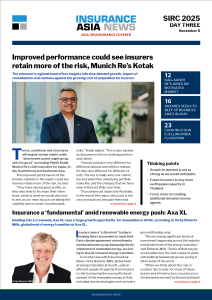‘Bright future’ for structured solutions in APAC as awareness grows: Guy Carpenter
November 4 2024 by Mithun Varkey
A significant increase in the need to bridge gaps between clients’ risk appetites and reinsurers’ demands for higher retentions continues to be a key theme for the structured solutions market in Asia Pacific as we approach 2025, according to Hussain Ahmad, head of structured reinsurance solutions, Asia Pacific, Guy Carpenter.
“Structured solutions are broadly assisting re/insurers in three key strategic areas: capital management; efficient management of volatility, particularly in the lower layers of excess of loss programs; and market entry and exit strategy support. There is a significant demand for support in these areas across Asia Pacific,” said Ahmad.
However, the level of understanding of the capital and volatility benefits of reinsurance is evolving and varies across the region.
“Guy Carpenter has been at the forefront of educating market participants, and we see a bright future, as industry awareness grows with these solutions,” Ahmad said.
Market transition
“Structured solutions have always been tailored to meet specific client needs. As such, there has been constant evolution in the market. A key trend over the years has been towards more flexibility in terms for buyers, as these products gain mass appeal,” he said.
Regulatory changes and support play huge roles in how reinsurance solutions are used in the market.
The Asia Pacific region comprises more than a dozen countries and territories, each at different stages of regulatory sophistication and engagement.
“Structured solutions are broadly assisting re/insurers in three key strategic areas: capital management; efficient management of volatility, particularly in the lower layers of excess of loss programs; and market entry and exit strategy support. There is a significant demand for support in these areas across Asia Pacific.” Hussain Ahmad, Guy Carpenter
“We see a continued push to adopt risk-based capital frameworks, which open up more conversations around the use of reinsurance to manage capital,” Ahmad noted.
Additionally, some regulators in the region have been averse to allowing material changes to reinsurance structures, and we continue to engage with a few to facilitate common understanding of such solutions, he added.
ILS potential
The potential for the insurance-linked securities (ILS) market in Asia has been much talked about, however, it has yet to see widespread adoption.
While the usage and awareness are increasing in Asia Pacific, it is not on par with the US market.
Ahmad noted that there are a few factors that come into play regarding the differences.
One of the primary factors, Ahmad said is that the “availability and quality of underlying data from Asia Pacific remains a concern for investors, despite significant improvements in recent years”.
Regulatory acceptance of ILS and its impact on capital also needs to improve in markets around the region, he said.
“Cat bonds can compete on price/terms with traditional reinsurance particularly well for layers with low expected losses. However, we see the amount of catastrophe limits purchased in certain large countries in Asia Pacific to be lower (with higher expected loss) than their counterparts in the US and Europe, making traditional reinsurance more competitive,” Ahmad added.
“It is just a matter of time before we see markets evolving to adopt ILS in Asia Pacific, by sponsors as well as investors.”
Traditionally the largest issuers in the region have been the Japanese carriers. But Ahmad said that in addition to Japan, Guy Carpenter and GC Securities have helped sponsors in mainland China, Hong Kong, South Korea and Australia to access ILS capacity.
“At Guy Carpenter, we are taking the initiative in educating all the stakeholders on newer tools and structures that are becoming available to manage the evolving natural catastrophe risk,” he said.
-
Beazley | What does cyber protection look like from day 1 to day 600 and beyond?
Cybersecurity is no longer just an IT concern, but a governance issue that belongs on the boardroom agenda.
-
Sedgwick | Preparing for the next storm
Insurance industry needs to recalibrate, invest in innovation and strengthen systems, talent and data practices.
-
Peak Re | From climate modelling to market opportunity: Forging a new clarity on Southeast Asia’s climate risk
Southeast Asia's protection gap: a crisis of clarity, not just capital
-
BHSI WICare+ | Accelerating Payments, Empowering Recovery
Launched in cooperation with Steadfast’s Singapore network, WICare+ fills the gaps found in traditional coverage and keeps businesses and their workforce secure by covering up to SG$350,000 in medical expenses per claim.

